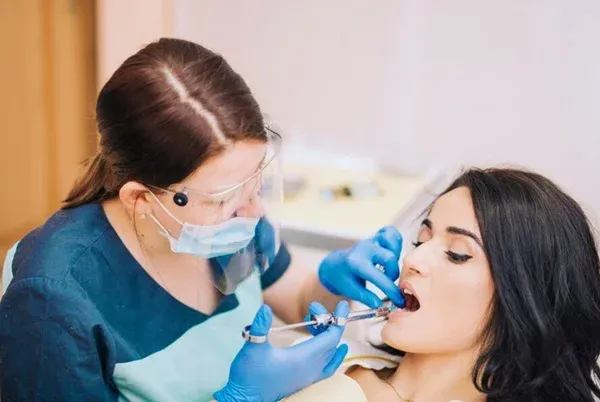Lost Fillings and Infections After Dental Procedures
Overall, proactive dental care and timely intervention are crucial to mitigating the risks associated with lost fillings and infections after dental procedures.

Differentiating types of Fillings, managing a Lost Filling, and recognizing signs of Infections Post-Dental Work
Losing a dental filling or experiencing infections after dental procedures can be concerning. However, understanding the causes and potential preventive measures is crucial. When a filling becomes dislodged, the tooth is vulnerable, exposing it to sensitivity and potential bacterial invasion.
Infections may occur when bacteria penetrate the tooth's inner pulp, leading to pain, swelling, and sometimes abscess formation. Such issues often arise from decay beneath the filling, wear and tear, or improper tooth sealing.
Prevent dental decay by scheduling regular check-ups and addressing any signs of decay promptly. Ensure your dental fillings are secure. If a filling is lost, seeking immediate dental attention is vital to prevent further complications.
Dentists may recommend either refilling the tooth or exploring alternative restoration options. Adopting a consistent oral care routine lowers the likelihood of infections or complications arising after dental procedures.
Overall, proactive dental care and timely intervention are crucial to mitigating the risks associated with lost fillings and infections after dental procedures.
"Dental fillings preserve oral health, but vigilance against potential infections is the key to a lasting smile."
Types of Dental Fillings
Dental fillings are essential for repairing teeth affected by decay or injury. Various dental filling types exist, each possessing unique characteristics. Comprehending the differences between these filling choices will equip you to make knowledgeable decisions regarding your dental well-being.

- Amalgam Fillings (silver fillings) have a well-established history of durability and cost-effectiveness. A blend of metals, including silver, tin, copper, and mercury, amalgam fillings are generally considered safe for most patients.
- Composite Fillings offer aesthetic appeal and functionality, contributing to a natural appearance for dental restorations. Composite fillings are durable and often used for small to mid-sized cavities.
- Ceramic Fillings: Ceramic or porcelain fillings are made of tooth-colored materials and are known for their natural appearance. They are resistant to staining and provide excellent durability.
- Glass Ionomer Fillings: Glass ionomer fillings provide additional protection against decay. While not as durable as some other types, they are often used for children or in areas of low bite pressure.
- Gold Fillings: Gold fillings, or gold inlays, are highly durable and well-tolerated by gum tissues. They are long-lasting but less common today due to their visible appearance and cost.
- Cermet Fillings: Cermet fillings combine metal and ceramic materials, offering the strength of metal and the aesthetics of ceramics. They are durable and resistant to wear but may not blend as seamlessly with natural teeth as other options.
The appropriate dental filling type hinges on the tooth's location, cavity size, aesthetic preferences, and budget considerations. Consulting with a dentist can provide personalized guidance based on your needs and preferences.
How to manage a Lost Filling?
Managing a lost filling requires prompt attention to alleviate discomfort and prevent further complications. Here are steps to take if you've lost a dental filling:
- Stay Calm and Assess: Evaluate the situation by examining yourself in the mirror to visually identify the absent filling or any exposed areas.
- Rinse with Warm Water: Cleanse your mouth gently to eliminate debris or food particles from the affected area. Avoid hot or cold water, as the exposed tooth may be sensitive.
- Clean the area: Carefully brush the affected and surrounding teeth using a soft-bristled toothbrush. Floss around the area to ensure no trapped food particles could irritate.
- Temporary Filling Material: Over-the-counter temporary dental filling materials are available at most pharmacies. These materials are often a quick and effective way to cover the exposed area temporarily. Follow the product instructions for application.
- Dental Wax or Sugar-Free Gum: If you cannot access temporary filling material, use dental wax or sugar-free gum to cover the exposed tooth.
- Avoid Certain Foods: Limit your consumption of extremely hot, cold, or sugary foods, as these may cause discomfort in the exposed tooth. Choose foods that are soft and gentle on the affected area.
- Over-the-Counter Pain Relief: Manage tooth pain by taking recommended over-the-counter pain relievers until you can see your dentist.
- Dental Appointment: It's crucial to contact your dentist as soon as possible to schedule an appointment. The exposed tooth needs professional attention to prevent further damage, sensitivity, or potential infection.
Remember, managing a lost filling at home is a temporary solution. Seeking urgent dental care is essential to ensure proper restoration and prevent any long-term issues with the affected tooth.
What are Some Types of Infection After Dental Procedures?
After dental procedures, various types of infections can occur, ranging from mild to more severe complications. Here are some common types of infections that may arise:
- Gingivitis: Gingivitis (mild gum disease) can occur after dental procedures if oral hygiene is not adequately maintained. Untreated gum disease can lead to the accumulation of plaque and bacteria along the gumline.
- Pericoronitis occurs when the tissue around a partially erupted tooth becomes inflamed. It often happens in the wisdom tooth area. Poor oral hygiene, trauma, or food debris trapped around the partially erupted tooth can contribute to pericoronitis.
- Abscess: Dental abscesses can arise when bacteria infect the tooth's pulp, the innermost part. This infection can extend to the surrounding tissues, causing intense pain, swelling, and systemic symptoms like fever.
- Alveolar Osteitis (Dry Socket): Alveolar osteitis is a painful condition that can arise following tooth extraction. It occurs when the blood clot, typically forming in the socket to safeguard the underlying bone, dissolves or dislodges. It exposes the bone, leading to intense pain.
- Cellulitis: Cellulitis is a bacterial infection that may manifest in the soft tissues of the face, neck, or mouth. It may result from the virus spread from a tooth or gum abscess. Cellulitis can cause swelling, redness, and tenderness in the affected area.
- Ludwig's Angina: Ludwig's angina is a severe, potentially life-threatening infection involving the mouth floor and the spaces between the tongue and neck. It can result from untreated dental infections and may cause difficulty breathing and swallowing.
- Systemic Infections: In rare instances, dental infections have the potential to spread to other body parts, resulting in systemic diseases. Such an occurrence can impact vital organs and may necessitate urgent medical attention.
Specific signs to look for After Post-Dental Work
While it's normal to experience some discomfort after dental procedures, persistent or worsening symptoms may indicate an infection. Here are some possible signs to be aware of:
- Prolonged Pain: Prolonged or severe pain beyond the initial recovery period may signal an infection. Pain that worsens over time is particularly concerning.

- Swelling and Redness: Swelling or redness around the treated area could indicate inflammation or infection. Monitor for unusual changes in your gums, cheeks, or face appearance.
- Persistent Bleeding: If bleeding continues for an extended period, immediately contact your dentist.
- Foul Taste or Odor: A persistent foul taste or unpleasant odor in your mouth may indicate the presence of infection. It could be a result of bacterial growth in the affected area.
- Fever: A fever is a systemic sign of infection. If you experience an unexplained rise in body temperature after dental work, seeking prompt medical attention is essential.
- Difficulty Swallowing or Breathing: If you notice any significant changes in your ability to swallow or breathe, seek immediate medical assistance.
- Pus Drainage: The presence of pus or discharge around the treated area is a clear sign of infection. It may co-occur with a bad taste in the mouth.
- Delayed Healing: If the healing process appears delayed, with persistent pain and no improvement in symptoms, it may indicate an underlying issue. This situation requires attention.
Final Thoughts
Although tooth fillings are vital for repairing teeth affected by decay or injury, it's important to remain vigilant for possible infections. If you notice any signs of infection, such as pain or swelling, it's imperative to seek prompt dental attention. Early detection and treatment can help prevent further complications and preserve oral health. Don't hesitate to contact your dentist immediately to address any concerns and ensure your teeth remain healthy and functional for the long term.
Contact your Walnut Creek Dentist, Dr. Tiziana Procopio Towle, DDS, at Procopio Towle Dental Office to learn about Lost Fillings and Infections After Dental Procedures.
Resource:
Why Should You Visit the Dentist Regularly?
*This media/content or any other on this website does not prescribe, recommend, or prevent any treatment or procedure. Therefore, we highly recommend that you get the advice of a qualified dentist or other medical practitioner regarding your specific dental condition.
Get to know us
The best and gentle Dentists and Team Member of Procopio Towle Dental Office are dedicated to providing top quality dental care to patients in Walnut Creek the surrounding San Francisco Bay Area.
Meet Our Dentist



